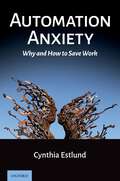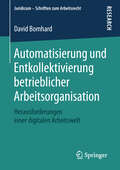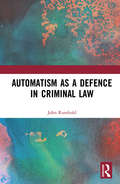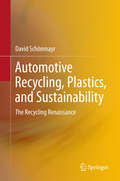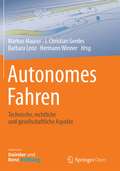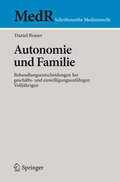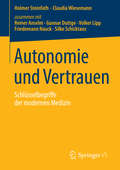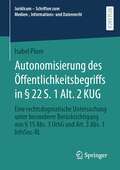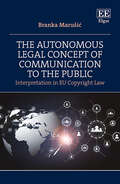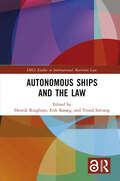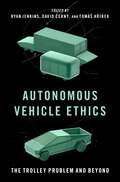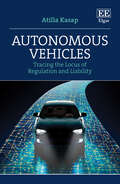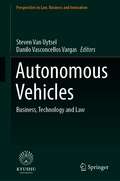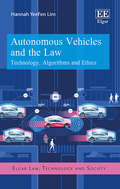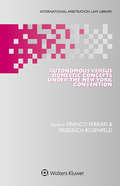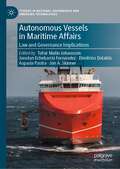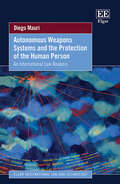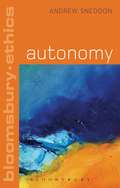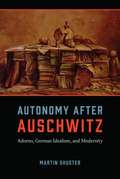- Table View
- List View
Automation Anxiety: Why and How to Save Work
by Cynthia EstlundAre super-capable robots and algorithms destined to devour our jobs and idle much of the adult population? Predictions of a jobless future have recurred in waves since the advent of industrialization, only to crest and retreat as new jobs-usually better ones-have replaced those lost to machines. But there's good reason to believe that this time is different. Ongoing innovations in artificial intelligence, machine learning, and robotics are already destroying more decent middle-skill jobs than they are creating, and may be leading to a future of growing job scarcity. But there are many possible versions of that future, ranging from utterly dystopian to humane and broadly appealing. It all depends on how we respond. This book confronts the hotly-debated prospect of mounting job losses due to automation, and the widely-divergent hopes and fears that prospect evokes, and proposes a strategy for both mitigating the losses and spreading the gains from shrinking demand for human labor. We should set our collective sights, it argues, on ensuring access to adequate incomes, more free time, and decent remunerative work even in a future with less of it. Getting there will require not a single "magic bullet" solution like universal basic income or a federal job guarantee but a multi-pronged program centered on conserving, creating, and spreading work. What the book proposes for a foreseeable future of less work will simultaneously help to address growing economic inequality and persistent racial stratification, and makes sense here and now but especially as we face the prospect of net job losses.
Automatisierung und Entkollektivierung betrieblicher Arbeitsorganisation: Herausforderungen einer digitalen Arbeitswelt (Juridicum - Schriften zum Arbeitsrecht)
by David BomhardDavid Bomhard untersucht in diesem Buch die Veränderung der Arbeitswelt durch Automatisierung und Digitalisierung hin zur „Arbeitsorganisation 4.0“. Im Zentrum stehen zwei Digitalisierungs-Aspekte: Einerseits kann Automatisierung von Arbeitgeberentscheidungen den Arbeitnehmer zum Objekt einer „Maschinenherrschaft“ machen. Andererseits wird die Arbeitsorganisation instabiler und fragmentarischer, was die Kollektive des kollektiven Arbeitsrechts bedroht, vor allem aber den Betrieb als Grundeinheit der Betriebsverfassung. Der digitale Wandel kann ohne eine wechselseitige Berücksichtigung technischer und rechtliche Aspekte nicht verstanden werden. Der Autor sucht diese Synthese.
Automatism as a Defence
by John RumboldAutomatism is a notoriously difficult subject for law students, lawyers and judges. This book explores the science and medicine of sleep disorders and examines how the criminal process deals with such disorders when presented as a defence. It systematically examines the legal doctrines involved, and their implications for the use of the evidence key to establishing automatism, while also exploring the medical conditions that can cause automatism (particularly epilepsy, sleepwalking and diabetes). This book is a valuable resource for law students, lawyers, judges and expert witnesses.
Automatism as a Defence
by John RumboldAutomatism is a notoriously difficult subject for law students, lawyers and judges. This book explores the science and medicine of sleep disorders and examines how the criminal process deals with such disorders when presented as a defence. It systematically examines the legal doctrines involved, and their implications for the use of the evidence key to establishing automatism, while also exploring the medical conditions that can cause automatism (particularly epilepsy, sleepwalking and diabetes). This book is a valuable resource for law students, lawyers, judges and expert witnesses.
Automotive Recycling, Plastics, and Sustainability: The Recycling Renaissance
by David SchönmayrThis book provides transdisciplinary analyses of the automotive plastics production and recycling system, including prognoses, scenarios and solutions for corporate sustainability management.A book on plastics, not written by a plastics guy. But a sustainability guy. Plastics schizophrenia and the automotive abyss: The industry is facing a severe challenge. It is the inevitable and promising change towards a sustainable economy. However, the automotive industry is primarily concerned with the CO2 emissions from cars when driving, while the rise of lightweight plastics, electric drive and heavy batteries make the production and end-of-life phase ever more important. Therefore, the currently increasing use of non-sustainable virgin plastics in cars has to be tackled.The plastics and the automotive industry now have a chance, and this chance is the Recycling Renaissance.This book offers:• Holistic and transdisciplinary overview on sustainability and automotive plastics from all angles including economy, ecology, technology, and politics with a focus on Europe• Concise analyses, prognoses, tools and a roadmap with solutions for companies, developed together with international experts from industry and academia • Strong scientific basis and independent research including a Europe-wide survey, expert interviews, and workshops• More than 80 illustrations and 15 tables including a SCOT analysis • Executive summaries after each chapter for fast reading“The uniqueness of this book lies within the different point of view on this topic from a critical, outstanding scientist.” - Univ.-Prof. Dipl.-Ing. Dr.mont. Pomberger, Montanuni Leoben
Autonomes Fahren: Technische, rechtliche und gesellschaftliche Aspekte
Ist das voll automatisierte, autonom fahrende Auto zum Greifen nah? Testfahrzeuge und Zulassungen in den USA erwecken diesen Eindruck, werfen aber gleichzeitig viele neue Fragestellungen auf. Wie werden autonome Fahrzeuge in das aktuelle Verkehrssystem integriert? Wie erfolgt ihre rechtliche Einbettung? Welche Risiken bestehen und wie wird mit diesen umgegangen? Und welche Akzeptanz seitens der Gesellschaft sowie des Marktes kann hinsichtlich dieser Entwicklungen überhaupt erwartet werden?Das vorliegende Buch gibt Antworten auf ein breites Spektrum dieser und weiterer Fragen. Expertinnen und Experten aus Deutschland und den USA beschreiben aus ingenieur- und gesellschaftswissenschaftlicher Sicht zentrale Themen im Zusammenhang mit der Automatisierung von Fahrzeugen im öffentlichen Straßenverkehr. Sie zeigen auf, welche „Entscheidungen“ einem autonomen Fahrzeug abverlangt werden beziehungsweise welche „Ethik“ programmiert werden muss. Die Autorinnen und Autoren diskutieren Erwartungen und Bedenken, die die individuelle wie auch die gesellschaftliche Akzeptanz des autonomen Fahrens kennzeichnen. Ein durch autonome Fahrzeuge erhöhtes Sicherheitspotenzial wird den Herausforderungen und Lösungsansätzen, die bei der Absicherung des Sicherheitskonzeptes eine Rolle spielen, gegenübergestellt. Zudem erläutern sie, welche Veränderungsmöglichkeiten und Chancen sich für unsere Mobilität und die Neuorganisation des Verkehrsgeschehens ergeben, nicht zuletzt auch für den Güterverkehr. Das Buch bietet somit eine aktuelle, umfassende und wissenschaftlich fundierte Auseinandersetzung mit dem Thema „Autonomes Fahren“.
Autonomie: Maßstab, Ideal oder Illusion? Vadian Lectures Band 9 (Sozialtheorie)
by Mathias Lindenau Marcel Meier KressigAutonomie und mit ihr die Selbstbestimmung gelten als hohes Gut. Demnach hat jeder Mensch das Recht, selbst darüber zu entscheiden, wie er leben möchte, und seine persönlichen Entscheide in der eigenen Lebensführung zu realisieren - und das ohne die Einmischung von anderen, auch staatlichen Stellen. Doch Selbstbestimmung ist nicht grenzenlos. Sie hat auch Rücksicht auf andere zu nehmen, deren Rechte zu achten und ist immer mit Verantwortung verbunden. Die Beiträger*innen des Bandes stellen sich diesem Spannungsfeld und fragen: Was heißt es unter diesen Vorzeichen, sich selbst zu bestimmen und ein gelungenes Leben zu führen? Und was bedeutet Autonomie für Entscheide am Lebensende und die personalisierte Medizin?
Autonomie und Familie: Behandlungsentscheidungen bei geschäfts- und einwilligungsunfähigen Volljährigen (MedR Schriftenreihe Medizinrecht)
by Daniel BrauerBeiträge zur Patientenautonomie gibt es viele. Was bisher aber kaum Beachtung gefunden hat, ist das Verhältnis zwischen Patientenautonomie und der Familie als personellem Nahraum. Das vorliegende Buch schließt diese Lücke, indem es die Bedeutung von Familienangehörigen bei medizinischen Entscheidungssituationen geschäfts- und einwilligungsunfähiger Patienten untersucht. Der Autor bereitet die Thematik systematisch auf, indem er, ausgehend von einer Darstellung eines Autonomiekonzepts und den Grundlagen der medizinischen Behandlung, der Kernfrage nachgeht, wie die Familie in den Entscheidungsfindungsprozess einbezogen wird und warum. Aufbauend auf diesen Erkenntnissen untersucht der Autor, ob aus der Einbeziehung der Familie eine Gefährdung für die Autonomie des Einzelnen folgt. Abschließend wendet sich der Autor der Beteiligung von Familienmitgliedern in den Rechtsordnungen der USA und den sich aus einem Rechtsvergleich ergebenden Handlungsimpulsen für das deutsche Recht zu.
Autonomie und Vertrauen: Schlüsselbegriffe der modernen Medizin
by Reiner Anselm Gunnar Duttge Volker Lipp Friedemann Nauck Silke SchicktanzDie Selbstbestimmung des Patienten wird in liberalen und individualisierten Gesellschaften zu Recht hochgehalten. Doch die Handlungsfreiheit des Einzelnen in einer hochkomplexen, von wissenschaftlich-technischen Rationalitäten durchstrukturierten Welt wächst nur in dem Maße, wie Personen- und Systemvertrauen ermöglicht wird. Denn mit den Handlungsmöglichkeiten der modernen Medizin wachsen auch Verletzlichkeit und Verunsicherung der Akteure. Die Beiträge dieses Bandes aus den Bereichen Philosophie, Medizinrecht, Theologie, Medizinethik und Medizin untersuchen, inwiefern interpersonelles Vertrauen bzw. Systemvertrauen und Selbstbestimmungspraktiken zusammenhängen. Ein besonderes Augenmerk gilt dabei Institutionen wie dem Krankenhaus sowie Kollektivakteuren wie Familien oder Patientengruppen.
Autonomisierung des Öffentlichkeitsbegriffs in § 22 S. 1 Alt. 2 KUG: Eine rechtsdogmatische Untersuchung unter besonderer Berücksichtigung von § 15 Abs. 3 UrhG und Art. 3 Abs. 1 InfoSoc-RL (Juridicum – Schriften zum Medien-, Informations- und Datenrecht)
by Isabel PlumDie Arbeit beschäftigt sich mit dem bildnisrechtlichen Öffentlichkeitsbegriff des § 22 S. 1 Alt. 2 KUG, den der Gesetzgeber trotz des massiven technischen Wandels und der herausragenden Bedeutung von Bildnissen im digitalen Zeitalter seit über 100 Jahren nicht novelliert hat. Vielmehr greift die überwiegende Meinung in der Rechtsprechung und der Literatur im Rahmen des § 22 S. 1 Alt. 2 KUG seit jeher auf das Verständnis des urheberrechtlichen Öffentlichkeitsbegriffs gemäß § 15 Abs. 3 UrhG zurück, der infolge der umfassenden Rechtsprechung des EuGH zu Art. 3 Abs. 1 InfoSoc-RL erhebliche Modifikationen erfahren hat. Die Arbeit widmet sich insoweit der Frage, ob für den bildnisrechtlichen Öffentlichkeitsbegriff tatsächlich der urheberrechtliche Öffentlichkeitsbegriff, die Vorgaben des Art. 3 Abs. 1 InfoSoc-RL sowie die hierzu ergangene Rechtsprechung des EuGH herangezogen werden können. Dabei werden erhebliche Unterschiede zwischen dem bildnisrechtlichen und dem urheberrechtlichen Öffentlichkeitsbegriff konstatiert, die eine Autonomisierung des bildnisrechtlichen Öffentlichkeitsbegriffs gebieten. Die Autorin entwickelt daher einen von § 15 Abs. 3 UrhG und Art. 3 Abs. 1 InfoSoc-RL losgelösten Öffentlichkeitsbegriff, der den bildnisrechtlichen Spezifika Rechnung trägt.
The Autonomous Legal Concept of Communication to the Public: Interpretation in EU Copyright Law
by Branka MarušićThe economic right of a copyright holder to communicate to the public has become an increasingly important and complex issue in recent years, this is partially due to changes in the way that content is accessed and consumed online. This innovative book analyses the right of communication to the public, taking account of what legal standing an autonomous legal concept can hold, and how this is impacted by wider harmonisation efforts at an EU level.The book explores the scope of the right of communication to the public in a twofold manner: Firstly, it examines the legal standing and effect, from a constitutional perspective of an autonomous legal concept. Secondly, it analyses CJEU case law, grouping cases by type of communication model to demonstrate what kind of authorisation is required to permit widened communication to the public online. Marušic builds on both strands of analysis to propose an operational model of communication for future use, that can aid in identifying and remedying infringements.Providing novel analysis on the definition and status of autonomous legal concepts in the EU, and setting this analysis against the context of harmonisation processes, this book will be of great interest to scholars working in both copyright law and EU law more widely.
Autonomous Ships and the Law (ISSN)
by Henrik Ringbom Erik Røsæg Trond SolvangInterest in autonomous ships has grown exponentially over the past few years. Whereas a few years ago, the prospect of unmanned and autonomous vessels sailing on the seas was considered unrealistic, the debate now centers on when and in what format and pace the development will take place.Law has a key role to play in this development and legal obstacles are often singled out as principal barriers to the rapid introduction of new technologies in shipping. Within a few years, autonomous ships have turned from a non-issue to one of the main regulatory topics being addressed by the International Maritime Organization. However, the regulatory discussion is still in its infancy, and while many new questions have been raised, few answers have been provided to them to date.Increased automation of tasks that have traditionally been undertaken by ships' crews raises interesting legal questions across the whole spectrum of maritime law. The first of its kind, this book explores the issue of autonomous ships from a wide range of legal perspectives, including both private law and public law at international and national level, making available cutting-edge research which will be of significant interest to researchers in maritime law.Chapter 3 of this book is freely available as a downloadable Open Access PDF at http://www.taylorfrancis.com under a Creative Commons Attribution-Non Commercial (CC-BY-NC) 4.0 license.
Autonomous Ships and the Law (ISSN)
by Henrik Ringbom Erik Røsæg Trond SolvangInterest in autonomous ships has grown exponentially over the past few years. Whereas a few years ago, the prospect of unmanned and autonomous vessels sailing on the seas was considered unrealistic, the debate now centers on when and in what format and pace the development will take place.Law has a key role to play in this development and legal obstacles are often singled out as principal barriers to the rapid introduction of new technologies in shipping. Within a few years, autonomous ships have turned from a non-issue to one of the main regulatory topics being addressed by the International Maritime Organization. However, the regulatory discussion is still in its infancy, and while many new questions have been raised, few answers have been provided to them to date.Increased automation of tasks that have traditionally been undertaken by ships' crews raises interesting legal questions across the whole spectrum of maritime law. The first of its kind, this book explores the issue of autonomous ships from a wide range of legal perspectives, including both private law and public law at international and national level, making available cutting-edge research which will be of significant interest to researchers in maritime law.Chapter 3 of this book is freely available as a downloadable Open Access PDF at http://www.taylorfrancis.com under a Creative Commons Attribution-Non Commercial (CC-BY-NC) 4.0 license.
Autonomous Vehicle Ethics: The Trolley Problem and Beyond
by Ryan Jenkins, David Černý and Tomáš Hříbek"A runaway trolley is speeding down a track" So begins what is perhaps the most fecund thought experiment of the past several decades since its invention by Philippa Foot. Since then, moral philosophers have applied the "trolley problem" as a thought experiment to study many different ethical conflicts - and chief among them is the programming of autonomous vehicles. Nowadays, however, very few philosophers accept that the trolley problem is a perfect analogy for driverless cars or that the situations autonomous vehicles face will resemble the forced choice of the unlucky bystander in the original thought experiment. This book represents a substantial and purposeful effort to move the academic discussion beyond the trolley problem to the broader ethical, legal, and social implications that autonomous vehicles present. There are still urgent questions waiting to be addressed, for example: how AVs might interact with human drivers in mixed or "hybrid" traffic environments; how AVs might reshape our urban landscapes; what unique security or privacy concerns are raised by AVs as connected devices in the "Internet of Things"; how the benefits and burdens of this new technology, including mobility, traffic congestion, and pollution, will be distributed throughout society; and more. An attempt to map the landscape of these next-generation questions and to suggest preliminary answers, this volume draws on the disciplines of philosophy, sociology, economics, urban planning and transportation engineering, business ethics and more, and represents a global range of perspectives.
Autonomous Vehicle Ethics: The Trolley Problem and Beyond
"A runaway trolley is speeding down a track" So begins what is perhaps the most fecund thought experiment of the past several decades since its invention by Philippa Foot. Since then, moral philosophers have applied the "trolley problem" as a thought experiment to study many different ethical conflicts - and chief among them is the programming of autonomous vehicles. Nowadays, however, very few philosophers accept that the trolley problem is a perfect analogy for driverless cars or that the situations autonomous vehicles face will resemble the forced choice of the unlucky bystander in the original thought experiment. This book represents a substantial and purposeful effort to move the academic discussion beyond the trolley problem to the broader ethical, legal, and social implications that autonomous vehicles present. There are still urgent questions waiting to be addressed, for example: how AVs might interact with human drivers in mixed or "hybrid" traffic environments; how AVs might reshape our urban landscapes; what unique security or privacy concerns are raised by AVs as connected devices in the "Internet of Things"; how the benefits and burdens of this new technology, including mobility, traffic congestion, and pollution, will be distributed throughout society; and more. An attempt to map the landscape of these next-generation questions and to suggest preliminary answers, this volume draws on the disciplines of philosophy, sociology, economics, urban planning and transportation engineering, business ethics and more, and represents a global range of perspectives.
Autonomous Vehicles: Tracing the Locus of Regulation and Liability
by Atilla KasapDelving deep into the emerging international and federal statutory and legislative developments surrounding Autonomous Vehicle (AV) technologies, Atilla Kasap assesses whether current motor vehicle regulations, liability law and the liability insurance system are fit for purpose today and in the future.Making a significant and novel contribution to the field, this cutting-edge book comprehensively surveys the promises offered by AVs, including radically reduced road incidents, and economic, environmental and societal benefits, alongside the significant regulatory and liability problems the technology faces. Kasap finds that, as AVs are one of the most significant and profound technological advances of the 21st century, relying on machine learning and pattern recognition systems to function, the current liability regime surrounding them requires a rethinking. Critically analysing the tort liability of AVs, chapters deconstruct and reconstruct a tort law regime for AVs, ultimately solving how policymakers should approach the challenges faced in regulating and enacting AV legislation.Interdisciplinary in approach, it will prove invaluable to students and scholars of computer science and law, particularly those studying AI and robotics law, and those interested in the regulation and governance of AV technology. It also offers vital tools for policymakers seeking concrete principles on which to define potential laws and regulations for AV technology.
Autonomous Vehicles: Business, Technology and Law (Perspectives in Law, Business and Innovation)
by Steven Van Uytsel Danilo Vasconcellos VargasThis edited book aims to address challenges facing the deployment of autonomous vehicles. Autonomous vehicles were predicted to hit the road by 2017. Even though a high degree of automation may have been achieved, vehicles that can drive autonomously under all circumstances are not yet commercially available, and the predictions have been adjusted. Now, experts even say that we are still decades away from fully autonomous vehicles. In this volume, the authors form a multidisciplinary team of experts to discuss some of the reasons behind this delay. The focus is on three areas: business, technology, and law. The authors discuss how the traditional car manufacturers have to devote numerous resources to the development of a new business model, in which the sole manufacturing of vehicles may no longer be sufficient. In addition, the book seeks to introduce how technological challenges are creating a shift toward connected autonomous vehicles. Further, it provides insight into how regulators are responding to the insufficiently tested technology and how lawyers try to answer the liability question for accidents with these autonomous vehicles.
Autonomous Vehicles and the Law: Technology, Algorithms and Ethics (Elgar Law, Technology and Society series)
by Hannah Y. LimAutonomous vehicles have attracted a great deal of attention in the media, however there are some inconsistencies between the perception of autonomous vehicles’ capabilities and their actual functions. This book provides an accessible explanation of how autonomous vehicles function, including comprehensive explanations of the artificial intelligence (AI) involved, software and hardware, and suggests appropriate regulatory responses to the existing and emerging technology. Hannah YeeFen Lim explores the current capabilities of autonomous vehicles and importantly, highlights their inherent limitations and expounds the machine learning and algorithm pitfalls. Lim provides a concise and easy to follow overview of the technology behind autonomous vehicles which encompasses hardware and software aspects, including machine learning algorithms. Having laid the technical foundation, the following chapters assess the current legal standards in negligence law that are applicable to autonomous vehicles taking into account the current technical limitations of the vehicles. Lim concludes by exploring the ethical issues associated with autonomous vehicles and proposes appropriate regulatory approaches. This book will be of great value to policy makers seeking a deeper understanding of the technology behind autonomous vehicles and the relevant legal landscape in order to inform and guide the development of policies, laws and regulations. Legal practitioners will benefit from the discussion of recent use cases and applicable negligence law. Legal scholars researching artificial intelligence will also find the author’s easy to understand technical explanations and discourse on ethical considerations invaluable.
Autonomous Versus Domestic Concepts under the New York Convention
by Franco Ferrari Friedrich RosenfeldInternational Arbitration Law Library # 61 The 1958 New York Convention is universally acclaimed as one of the most important instruments on international commercial arbitration. Although the Convention ensures that contracting States cannot justify failure to comply with their treaty obligations by reference to domestic law, the courts of different contracting States apply the Convention differently. This diverging case law arises from uncertainty as to whether certain concepts employed in the Convention must be construed autonomously or in light of domestic law. This incomparable analysis of the New York Convention as an instrument of uniform law presents insightful contributions by some of the world’s most distinguished academics and practitioners in the field of arbitration and is sure to significantly contribute to arbitral practice and jurisprudence in the Convention’s more than 160 contracting States. With extensive reference to case law from major arbitration hubs, the contributors examine the Convention with the aim of identifying the boundaries between autonomous and domestic concepts. Key elements covered include the following: the role of private international law under the Convention; notions of arbitrability and arbitral award; procedures for the enforcement of awards; nullity, invalidity, and conflict of laws under Articles II(3) and V(1)(a); the incapacity defence under Article V(1)(a); deviations from procedure; autonomous boundaries as to what falls under the issue of scope; and public policy under the Convention. The first and only resource of its kind, this book provides an invaluable clarification of the extent to which the Convention leaves room for the application of domestic law and, if so, how to determine which particular domestic law may be applicable. It will be welcomed by counsel, judges, arbitrators, and academics throughout the States that have signed the New York Convention.
Autonomous Vessels in Maritime Affairs: Law and Governance Implications (Studies in National Governance and Emerging Technologies)
by Tafsir Matin Johansson Jonatan Echebarria Fernández Dimitrios Dalaklis Aspasia Pastra Jon A. SkinnerThis first-of-its-kind incisive and interdisciplinary volume spears through law and governance implications in relation to maritime autonomous surface ships (MASS). The book focuses on a wide array of timely, topical and thorny issues under eight distinct parts: setting the scene; naval warfare and security; safety, seaworthiness and techno-regulatory assessments; global environmental change; autonomous passenger transportation; liability and insurance; selected national and regional developments; and tying the threads. Thus, the main themes will stress on topics including evolution, environment, safety and security, society, insurance, liability, human element, design solutions and procedures, and selected national case studies. At the outset, the book commences with an insight into the role of innovation-diplomacy as the driving force that could expedite the transition from autonomation to autonomy, and a commentary from the Chair of IMO’s MASS. After navigating through the complex law and governance landscape, the book concludes with a chapter that captures the essence of the paradigm shift and ties all critical findings for further consideration.Chapter 11 and Chapter 18 are available open access under a Creative Commons Attribution 4.0 International License via link.springer.com.
Autonomous Weapons Systems and the Protection of the Human Person: An International Law Analysis (Elgar International Law and Technology series)
by Diego MauriProviding a much-needed study of the weapons paradox in the case of autonomous weapons, this book is a detailed and comprehensive account of the current debate over the use of autonomous weapons – should some form of regulation be applied or a total ban be enforced? How can compliance with existing rules be ensured? Can responsibility be properly allocated? To what extent do concepts such as ‘human dignity’ and ‘humanity’ provide legal guidance in coping with technology? This book tackles these momentous challenges and strives to provide sound answers by elaborating on international law and proposing normative solutions for current and future human–machine interactions in this critical field. Diego Mauri expertly explains the complex new technological research involved in autonomous weaponry, with particular focus on technological developments that have elicited intense debates among diplomats, military experts, scientists, philosophers, and international lawyers. Providing innovative and original discussion of the effective protection of the human person in international law, this book will be welcomed by legal scholars, human rights lawyers, and researchers concerned with the relationship between international law and technology.
Autonomy (Bloomsbury Ethics)
by Andrew SneddonPhilosophers have various reasons to be interested in individual autonomy. Individual self-rule is widely recognized to be important. But what, exactly, is autonomy? In what ways is it important? And just how important is it? This book introduces contemporary philosophical thought about the nature and significance of individual self-rule.Andrew Sneddon divides self-rule into autonomy of choice and autonomy of persons. Unlike most philosophical treatments of autonomy, Sneddon addresses empirical study of the psychology of action. The significance of autonomy is displayed in connection with such issues as paternalism, political liberalism, advertising and physician-assisted suicide. Sneddon both introduces the themes of contemporary autonomy studies and defends a novel account of its nature and significance. Autonomy is an ideal introduction for advanced-level undergraduate and postgraduate students to the issues and debates surrounding individual self-rule.
Autonomy (Bloomsbury Ethics)
by Andrew SneddonPhilosophers have various reasons to be interested in individual autonomy. Individual self-rule is widely recognized to be important. But what, exactly, is autonomy? In what ways is it important? And just how important is it? This book introduces contemporary philosophical thought about the nature and significance of individual self-rule.Andrew Sneddon divides self-rule into autonomy of choice and autonomy of persons. Unlike most philosophical treatments of autonomy, Sneddon addresses empirical study of the psychology of action. The significance of autonomy is displayed in connection with such issues as paternalism, political liberalism, advertising and physician-assisted suicide. Sneddon both introduces the themes of contemporary autonomy studies and defends a novel account of its nature and significance. Autonomy is an ideal introduction for advanced-level undergraduate and postgraduate students to the issues and debates surrounding individual self-rule.
Autonomy After Auschwitz: Adorno, German Idealism, and Modernity
by Martin ShusterEver since Kant and Hegel, the notion of autonomy—the idea that we are beholden to no law except one we impose upon ourselves—has been considered the truest philosophical expression of human freedom. But could our commitment to autonomy, as Theodor Adorno asked, be related to the extreme evils that we have witnessed in modernity? In Autonomy after Auschwitz, Martin Shuster explores this difficult question with astonishing theoretical acumen, examining the precise ways autonomy can lead us down a path of evil and how it might be prevented from doing so. Shuster uncovers dangers in the notion of autonomy as it was originally conceived by Kant. Putting Adorno into dialogue with a range of European philosophers, notably Kant, Hegel, Horkheimer, and Habermas—as well as with a variety of contemporary Anglo-American thinkers such as Richard Rorty, Stanley Cavell, John McDowell, and Robert Pippin—he illuminates Adorno’s important revisions to this fraught concept and how his different understanding of autonomous agency, fully articulated, might open up new and positive social and political possibilities. Altogether, Autonomy after Auschwitz is a meditation on modern evil and human agency, one that demonstrates the tremendous ethical stakes at the heart of philosophy.
Autonomy After Auschwitz: Adorno, German Idealism, and Modernity
by Martin ShusterEver since Kant and Hegel, the notion of autonomy—the idea that we are beholden to no law except one we impose upon ourselves—has been considered the truest philosophical expression of human freedom. But could our commitment to autonomy, as Theodor Adorno asked, be related to the extreme evils that we have witnessed in modernity? In Autonomy after Auschwitz, Martin Shuster explores this difficult question with astonishing theoretical acumen, examining the precise ways autonomy can lead us down a path of evil and how it might be prevented from doing so. Shuster uncovers dangers in the notion of autonomy as it was originally conceived by Kant. Putting Adorno into dialogue with a range of European philosophers, notably Kant, Hegel, Horkheimer, and Habermas—as well as with a variety of contemporary Anglo-American thinkers such as Richard Rorty, Stanley Cavell, John McDowell, and Robert Pippin—he illuminates Adorno’s important revisions to this fraught concept and how his different understanding of autonomous agency, fully articulated, might open up new and positive social and political possibilities. Altogether, Autonomy after Auschwitz is a meditation on modern evil and human agency, one that demonstrates the tremendous ethical stakes at the heart of philosophy.
